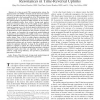Free Online Productivity Tools
i2Speak
i2Symbol
i2OCR
iTex2Img
iWeb2Print
iWeb2Shot
i2Type
iPdf2Split
iPdf2Merge
i2Bopomofo
i2Arabic
i2Style
i2Image
i2PDF
iLatex2Rtf
Sci2ools
TWC
2016
2016
Combating Strong-Weak Spatial-Temporal Resonances in Time-Reversal Uplinks
—In a time-reversal (TR) communication system, the signal-to-noise ratio (SNR) is boosted and the inter-user interference (IUI) is suppressed due to the spatial–temporal resonances, commonly known as the focusing effects, of the TR technique when implemented in a rich scattering environment. However, since the spatial–temporal resonances highly depend on the locationspecific multipath profile, there exists a strong–weak spatial– temporal resonances effect. In the TR uplink system, different users at different locations enjoy different strengths of spatial– temporal resonances, i.e., the received signal-to-interference-noise ratios (SINRs) for different users vary, and the weak ones can be blocked from correct detection in the presence of strong ones. In this paper, we formulate the strong–weak spatial–temporal resonances in the multiuser TR uplink system as a max–min weighted SINR balancing problem by joint power control and signature design. Then, a novel two-stage...
TWC 2016 |
| Added | 11 Apr 2016 |
| Updated | 11 Apr 2016 |
| Type | Journal |
| Year | 2016 |
| Where | TWC |
| Authors | Qinyi Xu, Yan Chen, K. J. Ray Liu |
Comments (0)

